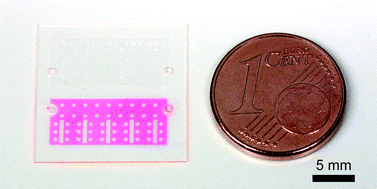Diffusion driven optofluidic dye lasers encapsulated into polymer chips†
Abstract
Lab-on-a-chip systems made of

* Corresponding authors
a
Institute of Microstructure Technology (IMT), Karlsruhe Institute of Technology (KIT), Karlsruhe, Germany
E-mail:
tobias.wienhold@kit.edu, timo.mappes@kit.edu
b Department of Micro and Nanotechnology, Technical University of Denmark, Ørsteds Plads, Building 345B, Kgs. Lyngby, Denmark
c
Institute for Applied and Numerical Mathematics, Karlsruhe Institute of Technology (KIT), Karlsruhe, Germany
Web: www.biophotonic-systems.com
Lab-on-a-chip systems made of

 Please wait while we load your content...
Something went wrong. Try again?
Please wait while we load your content...
Something went wrong. Try again?
T. Wienhold, F. Breithaupt, C. Vannahme, M. Brøkner Christiansen, W. Dörfler, A. Kristensen and T. Mappes, Lab Chip, 2012, 12, 3734 DOI: 10.1039/C2LC40494J
To request permission to reproduce material from this article, please go to the Copyright Clearance Center request page.
If you are an author contributing to an RSC publication, you do not need to request permission provided correct acknowledgement is given.
If you are the author of this article, you do not need to request permission to reproduce figures and diagrams provided correct acknowledgement is given. If you want to reproduce the whole article in a third-party publication (excluding your thesis/dissertation for which permission is not required) please go to the Copyright Clearance Center request page.
Read more about how to correctly acknowledge RSC content.
 Fetching data from CrossRef.
Fetching data from CrossRef.
This may take some time to load.
Loading related content
